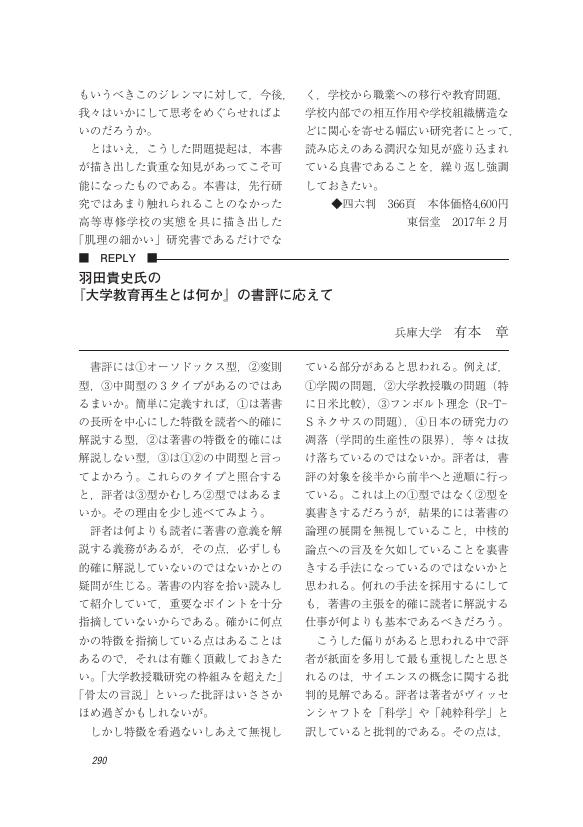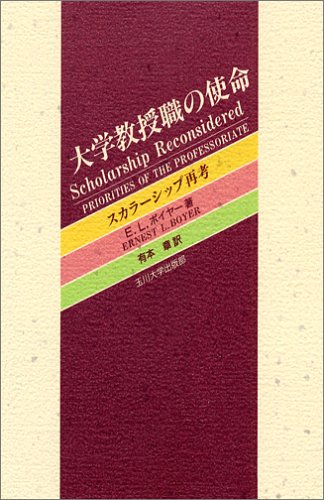21 0 0 0 大学教授の経歴型の国際比較
- 著者
- 新堀 通也 有本 章
- 出版者
- 日本社会学会
- 雑誌
- 社会学評論 (ISSN:00215414)
- 巻号頁・発行日
- vol.19, no.3, pp.2-21, 1969-01-30
- 被引用文献数
- 1
A great many people have discussed and made investigations on higher education, but few of them have pain attention to the nepotism and paternalism in the Japanese academic world. Radical student political movement and academic freedom are of course seriously important, but these problems will not be solved until we improve the quality of college professors and eliminate the pre-modern elements in the Japanese academic world.<BR>We have studied career patterns of college professors these five years and some of our previous findings were already published in the following publications : Nippon no Daigakukyoju Shijo (Academic Marketplace in Japan), 1965 ; Asahi Journal, Vol. 5, No. 47, Nov. 24, 1963 ; Comparative Study of Career Paterns of College Professors, International Review of Education, Vol. X, No. 3, 1964.<BR>In order to make a more detailed study on the relationship between education and career, the recruitment system, and the promotion system of professors in universities or colleges of various countries, we sent about 2, 000 questionnaires to professors in about 40 countries. About half of them were randomly chosen from the contributors to the latest academic journals in each country, and the another half were sampled from the World of Learning 1964-65.<BR>The questionnaire consists of the following three parts :<BR>1) personal history : age ; birth place ; citizenship ; education ; occupational career ; annual income ; position or status ; scholarly achievement.<BR>2) social origins : father's education and father's occupation<BR>3) administration and others : formal licence required for college professors such as German Habilitation or French Agrégation ; procedure of getting the doctor's degree ; the average age of getting degree ; the average age of getting degree ; the average standard and procedure of application for employment ; the procedure of appointment and promotion.<BR>The response rate was about 40 per cent. Because it was extremely difficult to get the accurate adresses of the respondents, the response rate was much lower than we had expected. Therefore the following analysis of the academic world cannot represent the whole situation in each country. We mainly analysed full professors in the following major countries : The U.S.A. ; the U.K. ; France ; Germany ; Italy ; Australia ; Canada. The responce rates in these countries were higher than average and the number of the respondents in these countries were large enough to be analysed independently.
2 0 0 0 OA 大学改革の現在-社会学的考察
1 0 0 0 OA 羽田貴史氏の『大学教育再生とは何か』の書評に応えて
- 著者
- 有本 章
- 出版者
- 日本教育社会学会
- 雑誌
- 教育社会学研究 (ISSN:03873145)
- 巻号頁・発行日
- vol.102, pp.290-291, 2018-05-31 (Released:2020-03-13)
1 0 0 0 OA 高等教育 その社会学的研究
1 0 0 0 OA キャリア・職業教育による高等教育の機能的分化と質保証枠組みに関する研究
- 著者
- 吉本 圭一 亀野 淳 稲永 由紀 塚原 修一 村澤 昌崇 椿 明美 藤墳 智一 江藤 智佐子 酒井 佳世 木村 拓也 志田 秀史 三好 登 川俣 美砂子 飯吉 弘子 濱中 義隆 新谷 康浩 伊藤 一統 松高 政 坂野 慎二 長谷川 祐介 沼口 博 内田 由理子 安部 恵美子 渡辺 達雄 永田 萬享 飯田 直弘 舘 昭 小方 直幸 伊藤 友子 立石 和子 有本 章 赤司 泰義 秋永 雄一 佐藤 弘毅 杉本 和弘 竹熊 尚夫 ジョイス 幸子 吉川 裕美子 菅野 国弘 TEICHER Ulrich LE MOUILLOUR Isabelle SCHOMBURG Harald 石 偉平
- 出版者
- 九州大学
- 雑誌
- 基盤研究(A)
- 巻号頁・発行日
- 2013-04-01
本研究は、ユニバーサル化した第三段階教育システムを対象とし、大学型・非大学型の教育プログラム単位での機能的分化と質保証のあり方を探究した。教育の目的・方法・統制の観点で、学術型とキャリア・職業型の教育を実証的に把握した。(1)共同IR型卒業生調査から学修成果の修得と活用、コンピテンシーの必要と修得という2つのベクトルがみられた。(2)非大学型教員調査の結果から機関の職業・地域志向性と個人の研究志向性との葛藤がみられた。(3)WILなどカリキュラム調査から教育高度化と内外ステークホルダー関与の方向性について、分野別の特徴を把握した。(4)国家学位資格枠組(NQF)から日本への示唆が得られた。
1 0 0 0 大学教授職の使命 : スカラーシップ再考
- 著者
- E. L. ボイヤー著 有本章訳
- 出版者
- 玉川大学出版部
- 巻号頁・発行日
- 1996



